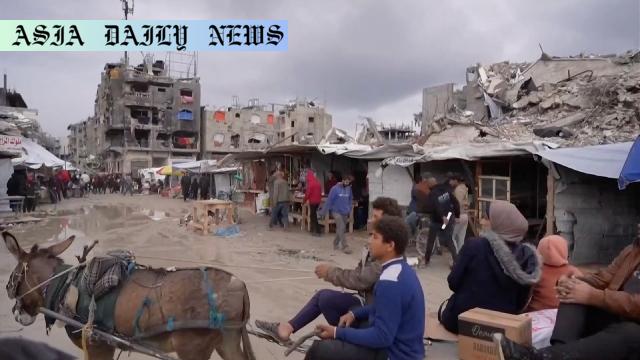Ceasefire: Israel agrees to US framework extending Gaza truce and calling for hostages’ release amidst heated negotiations.
Israel agrees to a US-led framework for extending the Gaza ceasefire until April.
The plan includes the release of half the hostages held by Hamas in the initial phase.
Hamas demands complete Israeli withdrawal and a comprehensive prisoner exchange deal.
Halted humanitarian aid raises tension and highlights regional stakes in the crisis.

Introduction to the Gaza Ceasefire Extension
The ongoing conflict in Gaza has witnessed a significant development as Israel has reportedly agreed to a United States-backed proposal to extend the existing ceasefire. The framework put forward aims to mediate peace while addressing sensitive hostage-release negotiations with Hamas. The proposed extension will run until late April and has injected a renewed sense of urgency and complexity into resolving the years-long conflict in the region.
This announcement follows the conclusion of the initial six-week ceasefire, which both sides agreed to earlier. While the first phase addressed a temporary reduction in hostilities, the second phase emphasizes further de-escalation, including the withdrawal of Israeli forces from Gaza in exchange for the complete release of hostages held by Hamas. Let’s delve into the particulars of this historic and polarizing development.
Details of the Current Ceasefire Framework
The new framework, proposed with backing from US presidential envoy Steve Witkoff, outlines critical steps to stabilize the region. On the first day of the agreed-upon extension, Hamas is expected to release half of the 59 hostages it currently holds. This includes both living and deceased captives. Complete resolution, which involves releasing the remaining hostages, hinges on successful negotiations to finalize a permanent ceasefire agreement. Israeli Prime Minister Benjamin Netanyahu’s office has expressed openness to this plan, with some preconditions that could decide its success.
However, Israel has complicated the situation by halting the entry of humanitarian aid into Gaza, citing pressure tactics to ensure Hamas complies with the terms of the agreement. This has sparked significant backlash, including accusations from Hamas of manipulative strategies that place the hostages’ lives at risk. Humanitarian agencies have also voiced concerns that this blockade further worsens the already dire living conditions for civilians in Gaza.
Hamas’ Demands and Strategic Implications
Hamas has remained firm in its demands for the complete withdrawal of Israeli forces from Gaza, alongside the comprehensive prisoner exchange deal included in phase two of the ceasefire. This escalates the stakes for both parties. For Hamas, the release of hostages serves as leverage, while Israel views their retrieval as paramount for any successful agreement. The cessation of humanitarian supplies adds yet another layer of tension.
The long-term implications of this proposal extend beyond immediate conflict-resolution efforts. If successful, this could mark a turning point in US diplomacy in the region, setting a precedent for future international mediation. However, the lingering mistrust between Israel and Hamas remains a critical hurdle in achieving sustained peace, even with US intervention. Concerns also arise about the wider Middle East’s economic and security frameworks, which are often affected by such regional instabilities.
Humanitarian and Global Concerns
The humanitarian cost of the blockade cannot be overstated. The Gaza Strip has been subjected to extreme hardship, with limited access to goods, water, and medical supplies. International agencies have criticized the Israeli government’s decision to block all entry points, claiming it exacerbates an already dire humanitarian crisis. Compounding this is the uncertainty faced by families of the hostages as political chess unfolds. The extension of the ceasefire brings hope but comes with high stakes for the vulnerable civilian population.
Meanwhile, global stakeholders, including the United Nations and international peace organizations, have urged for restraint and constructive dialogue. The ceasefire extension, they argue, provides a window for both sides to address humanitarian needs while charting a clear path toward long-term peace. Critics, however, remain skeptical of whether the proposed measures address root causes or merely offer a temporary halt to violence.
Conclusion and Future Outlook
The extension of the Gaza ceasefire is a critical yet contentious step in the quest for peace in the region. While Israel’s acceptance of the US proposal symbolizes a willingness to negotiate, the halted entry of humanitarian aid raises ethical and practical questions about its approach. Hamas’ demands and regional geopolitics serve as added barriers to peace. Nevertheless, the coming months will be pivotal. Success hinges on diplomatic finesse, mutual concessions, and global support for sustainable measures.
Commentary
Political Implications of the Ceasefire Extension
The extension of the Gaza ceasefire underscores the tenuous balance of power and diplomacy in one of the world’s most volatile regions. Israel’s acceptance of the US framework can be seen as a critical move toward de-escalation. However, the decision to halt humanitarian aid simultaneously, despite the conducive nature of the ceasefire, could very well inflame existing tensions both in Gaza and internationally. While some view this maneuver as a calculated strategy to pressure Hamas into compliance, others describe it as a thinly veiled tactic that risks the lives of both hostages and civilians.
The Hostage Situation and Humanitarian Concerns
Hamas’ utilization of hostages as a bargaining chip introduces a grim dimension to these talks. This raises profound moral and humanitarian questions. Unlike prior temporary agreements, this ceasefire framework ties hostage outcomes directly to parameters for peace—placing captives and their families in the heart of a bitter feud. For civilians in Gaza, the immediate concern extends beyond the prospect of peace to fundamental survival. Blocked goods and aid shipments could soon translate to a humanitarian catastrophe, further fueling animosity and distrust in the process.
Global and Historical Context
History has demonstrated that achieving peace in regions rife with conflict is rarely linear. The US has played an instrumental role in orchestrating past ceasefires, but enduring change demands a commitment from all parties to address systemic issues. Whether this framework will overcome these deep-rooted challenges remains to be seen. For now, the extension acts as a temporary reprieve, offering vital opportunities for international stakeholders to intervene effectively and encourage cooperative dialogue.


